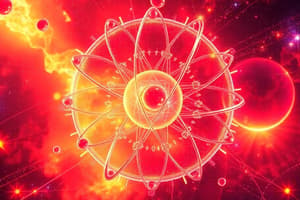Podcast
Questions and Answers
Which concept, introduced by Democritus, remains a fundamental principle in modern chemistry?
Which concept, introduced by Democritus, remains a fundamental principle in modern chemistry?
- The four elements: earth, fire, air, and water.
- Atoms having uniform sizes.
- The indivisibility of atoms.
- The existence of atoms. (correct)
How did Aristotle's view of matter differ significantly from that of Democritus?
How did Aristotle's view of matter differ significantly from that of Democritus?
- Aristotle rejected the existence of atoms, proposing four fundamental elements instead. (correct)
- Aristotle proposed that all matter was composed of atoms with varying sizes.
- Aristotle believed in atoms moving in constant motion, while Democritus did not.
- Aristotle thought energy was released when atoms released light when jumping from orbit, while Democritus did not.
Which statement accurately describes Dalton's atomic theory?
Which statement accurately describes Dalton's atomic theory?
- All matter is composed of indivisible particles called atoms. (correct)
- Atoms can be created or destroyed during chemical reactions.
- Atoms of the same element have different properties.
- Atoms of different elements are identical in their properties.
What key discovery is attributed to J.J. Thomson's experiments?
What key discovery is attributed to J.J. Thomson's experiments?
How did Rutherford's gold foil experiment change the understanding of atomic structure?
How did Rutherford's gold foil experiment change the understanding of atomic structure?
Why was Rutherford's postulation of the neutron significant, even before its experimental discovery?
Why was Rutherford's postulation of the neutron significant, even before its experimental discovery?
What was James Chadwick's primary contribution to atomic theory?
What was James Chadwick's primary contribution to atomic theory?
How did Thomson's model of the atom differ from Rutherford's model?
How did Thomson's model of the atom differ from Rutherford's model?
According to atomic theory, what happens to atoms during a chemical reaction?
According to atomic theory, what happens to atoms during a chemical reaction?
Why did some alpha particles deflect at large angles in Rutherford's gold foil experiment?
Why did some alpha particles deflect at large angles in Rutherford's gold foil experiment?
How did Bohr incorporate the concept of energy levels into the atomic model?
How did Bohr incorporate the concept of energy levels into the atomic model?
What limitation in Dalton's atomic theory was addressed by later discoveries?
What limitation in Dalton's atomic theory was addressed by later discoveries?
Why was the discovery of isotopes important for refining the understanding of atomic structure?
Why was the discovery of isotopes important for refining the understanding of atomic structure?
How does the concept of quantized energy levels explain the emission spectra of elements?
How does the concept of quantized energy levels explain the emission spectra of elements?
What role did empty space play in Rutherford's interpretation of the gold foil experiment?
What role did empty space play in Rutherford's interpretation of the gold foil experiment?
What evidence supports the claim that electrons further from the nucleus have more energy?
What evidence supports the claim that electrons further from the nucleus have more energy?
How does the concept of 'constant motion' as described by Democritus relate to modern physics?
How does the concept of 'constant motion' as described by Democritus relate to modern physics?
Which of the following best explains why atoms of different elements have different properties according to Dalton's theory?
Which of the following best explains why atoms of different elements have different properties according to Dalton's theory?
What experimental evidence led Rutherford to conclude that most of an atom’s mass is concentrated in the nucleus?
What experimental evidence led Rutherford to conclude that most of an atom’s mass is concentrated in the nucleus?
How did the concept of 'empty space' evolve from Democritus to Rutherford?
How did the concept of 'empty space' evolve from Democritus to Rutherford?
Flashcards
Democritus's Idea of Atoms
Democritus's Idea of Atoms
Indivisible and exist. They have different sizes, empty space and are in constant motion.
Dalton's Atomic Theory
Dalton's Atomic Theory
All matter is made of atoms; same element = same atoms, different element = different atoms. Atoms are never created or destroyed, just rearranged during reactions.
Thomson's Atomic Model
Thomson's Atomic Model
Atoms have electrons, are neutral, and the rest of the atom is positive with electrons evenly distributed.
Rutherford's Model of the Atom
Rutherford's Model of the Atom
Signup and view all the flashcards
Rutherford's Gold Foil Experiment Findings
Rutherford's Gold Foil Experiment Findings
Signup and view all the flashcards
Rutherford's Discovery (1920)
Rutherford's Discovery (1920)
Signup and view all the flashcards
Chadwick's Discovery (1932)
Chadwick's Discovery (1932)
Signup and view all the flashcards
Aristotle's Elements
Aristotle's Elements
Signup and view all the flashcards
Study Notes
- Democritus in 400 BCE realized atoms are indivisible and exist
- Atoms have different sizes, empty space and constant motion
- Aristotle in 450 BCE opposed atoms
- The four elements are earth, fire, air and water which have properties of dry, wet, hot, and cold
- Dalton in 1807 stated that all matter is made of atoms
- Atoms of the same element are identical
- Atoms of different elements are different
- Atoms are never created or destroyed, just rearranged for chemical reactions
- Could not explain attraction
- Thomson in 1897 found that atoms have electrons and are neutral
- Remainder of the atom is positive with electrons evenly distributed
- Rutherford in 1909 discovered the center of atom has positively charged nucleus
- Nucleus occupies little space but weighs a lot and is mostly empty space
- Electrons surround the nucleus
- Rutherford in 1920 proposed the existence of protons
- Believed there needed to be something neutral
- Electrons orbit nucleus and have finite energy: further from nucleus = stronger atom
- Electrons can jump orbits
- Energy (light) is released when jumping from one orbit to another
- Chadwick in 1932 stated that the nucleus has neutrons
- Electrons circle the nucleus
- Gold foil test showed the atom is an empty sphere around with dense nucleus
- Predicted positive particles would pass through gold
- Many passed through, but some were deflected implying positive central mass
- Neutron & electron have same mass
Studying That Suits You
Use AI to generate personalized quizzes and flashcards to suit your learning preferences.





